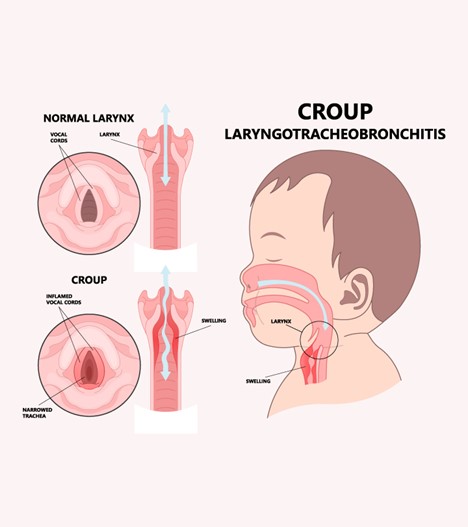What distinguishing manifestation of spasmodic croup should parents be taught to identify?
The child has a high fever.
It has a harsh, barky cough.
It is bacterial in nature.
Wheezing is heard audibly.
The Correct Answer is B
The correct answer is choice B. It has a harsh, barky cough.
Choice A rationale:
Spasmodic croup is characterized by sudden-onset symptoms, including a barking cough, but it is not typically associated with a high fever. The barky cough is caused by inflammation and narrowing of the upper airways, leading to a distinct sound when the child coughs.
Choice B rationale:
A harsh, barky cough is a hallmark symptom of spasmodic croup. It is caused by the swelling of the vocal cords and the upper airway, resulting in the characteristic sound. This type of croup is often triggered by viral infections and is usually not bacterial in nature.
Choice C rationale:
Spasmodic croup is usually of viral origin rather than bacterial. Bacterial infections may lead to other respiratory conditions, but they are not a distinguishing feature of spasmodic croup.

Choice D rationale:
Wheezing is not a typical manifestation of spasmodic croup. Wheezing is often associated with lower airway conditions such as asthma, while croup primarily affects the upper airways and vocal cords, leading to the barking cough.
Nursing Test Bank
Naxlex Comprehensive Predictor Exams
Related Questions
Correct Answer is A
Explanation
The correct answer is choice A: Anaphylactic shock.
Choice A rationale:
Anaphylactic shock is the correct answer. Anaphylactic shock is a severe and potentially life-threatening allergic reaction that causes massive vasodilation, capillary leakage, and bronchoconstriction. It can occur rapidly after exposure to an allergen such as certain foods, insect stings, medications, or latex. The release of histamine and other inflammatory mediators leads to systemic vasodilation and increased permeability of blood vessels, resulting in a sudden drop in blood pressure and compromised organ perfusion.
Choice B rationale:
Cardiogenic shock is characterized by inadequate cardiac output due to severe heart dysfunction. It is typically caused by conditions like myocardial infarction, heart failure, or other cardiac issues. While allergic reactions can potentially affect the cardiovascular system, the symptoms described in the question are more indicative of anaphylactic shock.
Choice C rationale:
Neurogenic shock results from disruption of sympathetic nervous system control over blood vessel tone, often due to spinal cord injury or severe emotional distress. This leads to widespread vasodilation and a sudden drop in blood pressure. While it can cause hemodynamic instability, it doesn't specifically involve the hypersensitivity reaction and capillary leaks associated with anaphylactic shock.
Choice D rationale:
Hypovolemic shock is caused by a significant loss of blood volume or bodily fluids, leading to decreased intravascular volume and subsequent inadequate tissue perfusion. This shock type is not directly related to a hypersensitivity reaction or capillary leakage caused by allergic responses. 2 / 2
Correct Answer is B
Explanation
The correct answer is choice b. Grasp the tick by the body to remove.
Choice A rationale:
Cleansing the wound with soap and water is a correct action. It helps to prevent infection after the tick has been removed.
Choice B rationale:
Grasping the tick by the body is incorrect. The proper method is to use fine-tipped tweezers to grasp the tick as close to the skin’s surface as possible and pull upward with steady, even pressure. Grasping the tick by the body can cause the mouth-parts to break off and remain in the skin, increasing the risk of infection.
Choice C rationale:
Leaving the tick in place and seeking emergency medical treatment is not recommended. The tick should be removed as soon as possible to reduce the risk of disease transmission.
Choice D rationale:
Avoiding touching the tick with bare hands is correct. Using gloves or tissue to handle the tick helps prevent the transmission of pathogens.
Whether you are a student looking to ace your exams or a practicing nurse seeking to enhance your expertise , our nursing education contents will empower you with the confidence and competence to make a difference in the lives of patients and become a respected leader in the healthcare field.
Visit Naxlex, invest in your future and unlock endless possibilities with our unparalleled nursing education contents today
Report Wrong Answer on the Current Question
Do you disagree with the answer? If yes, what is your expected answer? Explain.
Kindly be descriptive with the issue you are facing.
